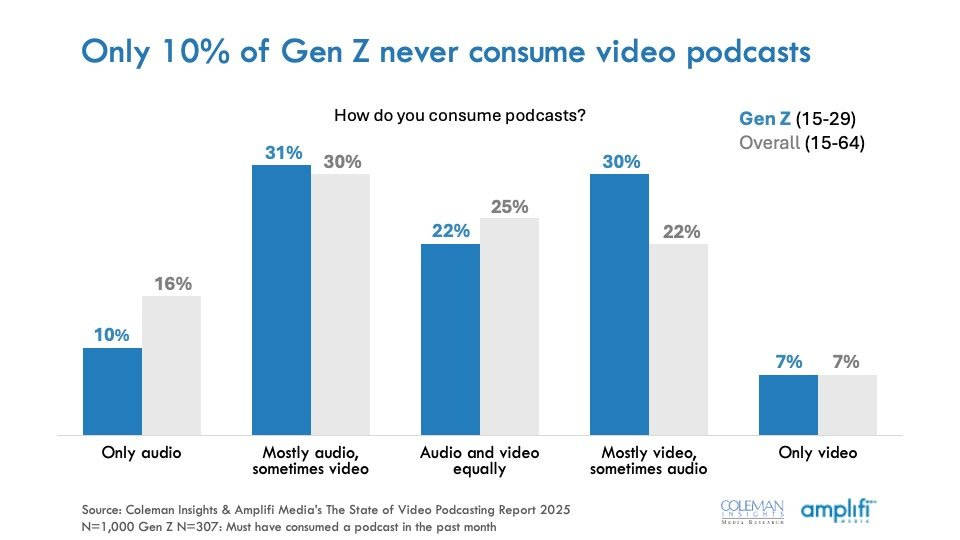Video Podcasting Revolution: Gen Z's Viewing Habits Transform the Industry
A startling 90% of Gen Z podcast users view video podcasts at some level, indicating a basic change in how content is consumed over generations. Although this generation loves visual components, the research also reveals interesting nuance: 41% of Gen Z still mostly listens to podcasts in audio form, suggesting that effective podcast strategies call for a careful multi-format approach rather than total abandonment of traditional audio.
The State of Video Podcasting 2025: Key Findings
According to the landmark study "The State of Video Podcasting 2025" conducted by Coleman Insights and Amplifi Media, video has become an essential component of the podcasting landscape. Only 10% of Gen Z podcast consumers report never watching video podcasts, while 84% of podcast listeners across all demographics engage with video podcasts to some degree. These findings will be explored in depth at the upcoming Podcast Movement keynote on April 3 in Chicago, presented by Steve Goldstein, Founder/CEO of Amplifi Media, and Jay Nachlis.
The Key Points:
Only 10% of Gen Z podcast consumers never watch video podcasts
41% of Gen Z still primarily consumes podcasts via audio format
84% of all podcast listeners (ages 15-64) engage with video podcasts at some level
The full study will be unveiled at Podcast Movement on April 3 in Chicago
Video podcasting represents a transformation, not just a trend, in content consumption
Why It Matters
The dramatic shift toward video podcasting fundamentally changes how creators need to approach content development, distribution strategies, and audience engagement. Understanding that both video and audio formats remain valuable - with different strengths depending on audience segments - gives podcasters crucial insight for making informed production decisions. This isn't simply about adding cameras to recording sessions, but about strategically developing content that works across multiple formats to maximize reach and impact.
The Big Picture
For podcasters and producers, this evolution presents both challenges and opportunities. The video podcast revolution creates new pathways for audience growth, especially among younger demographics, while opening additional monetization channels through visual sponsorships and platform-specific features. Producers must now develop production workflows that efficiently create compelling content for both audio and visual consumption, potentially requiring new skills and equipment investments. The industry as a whole benefits from expanded distribution options across YouTube and other video platforms, potentially reaching audiences who might never have discovered podcasts in audio-only formats.
How Podcasters Can Take Action
To capitalize on this trend, podcasters should consider implementing a dual-format strategy. Begin by evaluating your current setup for video readiness, investing in basic video equipment if necessary. Design content that works in both formats - consider visual demonstrations, graphics, or camera angle changes that enhance the video experience without diminishing audio-only value. Develop platform-specific distribution plans that leverage YouTube's algorithm while maintaining presence on traditional podcast platforms. Finally, consider format-specific monetization strategies, as video opens opportunities for visual product placement and sponsorships that differ from audio-only endorsements.
This analysis is based on findings from "The State of Video Podcasting 2025" by Coleman Insights and Amplifi Media, as reported by Steven Goldstein, Founder/CEO of Amplifi Media and Adjunct Professor at NYU, where he teaches "The Business of Podcasting." Goldstein, an internationally recognized executive in audio initiatives, will present the full study with Jay Nachlis at Podcast Movement on April 3, 2025, in Chicago.
Editorial Discretion Notice
This publication reserves the right to determine what content to publish, how to present it, and when it appears. Our editorial team makes independent decisions based on journalistic standards, newsworthiness, and audience relevance. While we strive for fairness and balance, we cannot cover every story or perspective. Opinion pieces do not necessarily reflect our official position. We remain committed to accurate, ethical journalism that serves the public interest.
If you found this valuable, consider Restacking so more people can see it.
Despite the financial challenges that our industry faces, we have decided to keep our reporting open to the public because we believe that everyone has the right to know the truth about the events that shape their world.
Thanks to the support of our readers, we can continue to provide free reporting. If you can, please choose to support The Podwires




